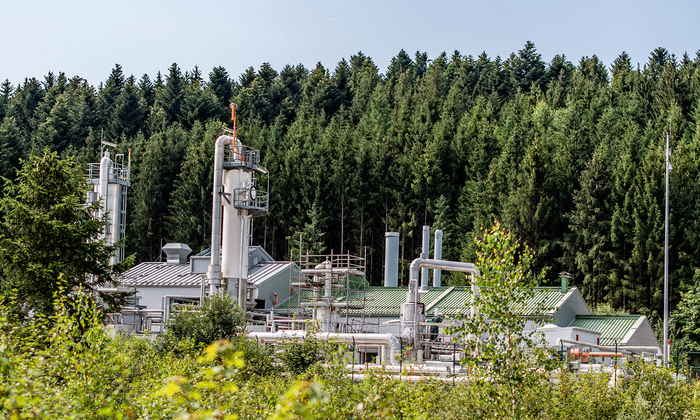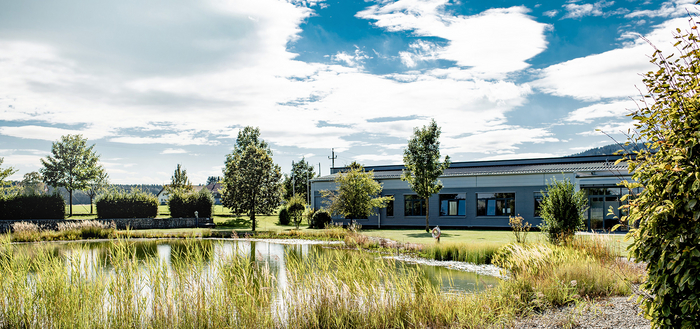
We want to make a significant contribution to the success of the European Union’s Green Deal initiative and the decarbonisation of Europe by developing and implementing projects related to environmentally friendly energy storage.
![]()
We are aware that GHGs and airborne emissions are currently generated through the operation of our plants, extraction and storage of oil and gas, and by the subsequent use of these raw materials in the regional supply of electricity, heat and transportation fuels. Our aim is to reduce such emissions and we are working to do so in all of the areas that we are able to influence. Climate protection and ensuring security of supply at the same time present us with major challenges; the aim is to cut our greenhouse gas emissions to zero by 2040 at the latest, while our airborne emissions also need to be cut significantly during this period.
The EU continues to see natural gas as a bridging technology in the transition to renewable forms of energy. In terms of the European taxonomy, too, there is now recognition that natural gas will also have to be used for energy generation in the medium term, especially in cold seasons. RAG is making a significant contribution to Austria’s energy supply independence through the provision of locally-produced, domestic natural gas that does not involve lengthy transportation routes from abroad. This likewise applies to Austrian crude oil production, where crude oil is taken by rail for high-quality processing or refining in the refinery by the shortest route.
As a basic material for the chemical and petrochemical industry, crude oil remains an indispensable component in the supply chain. The multitude of complex, naturally occurring chemical compounds found in crude oil are indispensable for organic chemistry producers’ operations. Production, storage and transportation are all carried out in strict compliance with the most stringent safety standards to help protect people and the environment.

Since 2020, the company strategy and business plan have formulated targets for reducing GHG emissions. Following approval by the Supervisory Board these are backed by a substantial budget each year. The company’s long-term objectives are also constantly updated and fine-tuned as part of the annual definition of its goals. To help implement the measures needed to achieve our strategic emissions targets, a central energy and emissions management office was implemented in February 2021. Its manager – whose responsibilities include ongoing energy monitoring as well as analysis of consumption (electricity, gas, heat, etc.) and the evaluation and implementation of potential energy-saving measures – reports directly to the Executive Board.
The company has been conducting measurement campaigns using state-of-the-art measuring equipment to facilitate internal monitoring and inspection of the operating facilities for several years now. This process allows us to take specific measures to help reduce our methane emissions.
We are also trying to cut greenhouse gas emissions at our plants by planning our maintenance and monitoring activities as effectively as possible. The recovery and recirculation of gas is being promoted through expansion in low-pressure systems and extraction techniques.
In terms of investment projects that generate emissions as part of ongoing operations, the most important Scope 1 emissions of the relevant greenhouse gases are already taken into account during the approval process for project applications. Preference is given to low-GHG or GHG-free investments despite the higher investment costs. Already on hand to provide consulting support in the planning phase, the emissions manager is also responsible for assessing emissions as part of the approval process.
We are reducing transport-related emissions through the use of vehicles with alternative drive systems, such as electric cars and a natural gas-powered fleet of cars with CNG or LNG for heavy goods transport. We are supporting these measures by rolling out the necessary refuelling infrastructure (RAG’S own charging points, and CNG and LNG filling stations) and the steadily increasing use of biomethane. This move also has the potential to cut fine particulate emissions significantly compared to conventional fuel types.
RAG is actively involved in various national and international committees concerned with establishing regulations for limiting methane emissions in the EU. In Austria, we are participating in national projects to determine emission factors in the natural gas sector while also playing a role in the Austrian Association for Gas and Water’s (ÖVGW) technical working group for the reduction of methane emissions.
In 2022, we substituted the natural gas-powered units needed for energy production at the combined heat and power plant in Voitsdorf with hydrogen-ready equivalents. The design phase for the replacement of the storage compressor drives at the Puchkirchen site will start in mid-2023. The switch from gas turbines to electric propulsion is expected to begin in 2025. Virtually 100 % inert gas utilisation and recycling was achieved in the CHP plant in Puchkirchen.

All of our facilities operate within the officially mandated framework. We continuously demonstrate compliance with the applicable limits, with evidence provided by independent testing institutes. In addition, to further minimise emissions, continuous emission monitoring is now being installed at critical points. Here, too, the aim is to achieve seamless monitoring and accounting of atmospheric emissions. In parallel, alternative technologies to reduce airborne emissions are being examined and, if possible and feasible, installed at our plants. Due to the use to date of natural gas as a fuel, which is chemically very precisely defined, RAG only generates very limited categories of other airborne emissions. The fine particulate emissions from using gas, for example, are negligible.
Even so, the company is also pursuing the goal of reducing or completely avoiding airborne emissions, specifically with a view to enhancing climate protection. Ongoing energy efficiency gains help us to avoid using additional quantities of natural gas, which itself brings about a significant reduction in emissions. Information on ongoing projects to cut energy consumption and enhance energy efficiency is published in the annual energy report, while key figures and performance indicators are used for control and continuous improvement purposes.